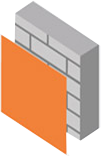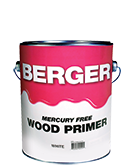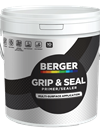Features
See allSurface preparation:
- Surface to be primed must be clean, dry and free from contaminants
- Treat mould, moss or algae with Berger Sterilizing Solution
- Allow to dry thoroughly
- Fill and repair all cracks and joints
- Remove any flaking or blistering paint by chemical or mechanical means
Application Procedure:
- Application by brush, roller or spray
- Stir well before use
- Apply with a brush and work well into the wood grain
- Apply a full coat, allow to dry overnight
- Sand back using #150-180 grit paper
- If necessary re-coat areas that show substrate after sanding
- Clean brushes and equipment with Berger No.2 Reducer
- Coverage is dependent on texture and porosity of the surface
Tips: When priming, plan to sand the surface before and also between coats. It helps the primer and topcoats to adhere to the surface better.
Tools you will need
Available Packs

1 Coat
7-9 m2/ ltr**
Coverage
On well-prepared surfaces, as per the painting system recommended. Please refer to the Product Data Sheet for surface preparation and method of application.
** Actual coverage may vary from the quoted coverage due to factors such as method and condition of application, surface roughness, and porosity.
Solve Potential Paint Problems
The scaly pattern on your walls is called Alligatoring; which can be described as a patterned cracking appearance in the paint film, resembling the scales of an alligator.
What are the possible causes?
- Applying a hard, rigid coating, like an oil-based enamel, over a more flexible coating, like a water-based latex primer
- Applying the topcoat before the first coat has dried
- Loss of elasticity in the paint film due to the natural aging of paint
- Failure of the topcoat to bond smoothly with the basecoat
- Applying paint too thickly
- Rate of surface drying is significantly higher than base, in thickly applied paint
What is the solution?
- Remove old paint by scraping, sanding or chemical removal
- Wash with appropriate cleaner and allow surface to dry
- Sand glossy surface to dull finish for application of topcoat
- Ensure surface if sanded to a smooth finish
- Prime before applying premium acrylic paint such as Royale
- Berger recommends Berger Grip & Seal Multi-Surface Primer
We recommend you use these painting systems in order of base coat, first coat, and second coat:
The bubbles or blisters on your walls are called blistering. Paint blisters or bubbles occur when there is loss of adhesion between the paint film and underlying surface.
What are the possible causes?
- Applying oil-based paint over a damp or wet surface
- Moisture seeping through to the exterior surface from an interior source
- Exposure of latex paint film to moisture shortly after the paint has dried, especially in cases of poor surface preparation
What is the solution?
- If blisters do not go all the way down to the substrate, remove by scraping and sanding
- Repaint with premium Berger topcoat for wood or wall
- For interior wood & wall surfaces, Berger recommends Royale
- Blisters all the way down to the surface are a sign of a more significant source of moisture, which must be addressed before any painting can begin
- Once resolved, remove all loose paint and repair any loose caulking
- Allow surface to dry thoroughly before the application of an appropriate primer and a moisture resistant premium topcoat
We recommend you use these painting systems in order of base coat, first coat, and second coat:
The splitting of dry paint film through at least one coat. In early stages it appears as hairline cracks and in the later stages flaking occurs.
What are the possible causes?
- Applying low quality paint to the surface, with inadequate adhesion and flexibility
- Applying too thin a coat of paint to the surface
- Inadequate surface preparation
- Failure to prime bare wood before top-coating
- Oil paint hardens with age, until it eventually cracks
- Painting on damp wood
What is the solution?
- Remove loose paint or flaking paint by scraping or wire brushing
- Sand the area to feather the edges
- Prime bare spots
- Repaint with two coats of a premium paint
- Berger recommends 2 topcoats over 1 primer coat
We recommend you use these painting systems in order of base coat, first coat, and second coat:
Mildew is both an interior and an exterior problem found in damp areas receiving little or no sunlight. It appears as black, grey, green, or brown spots on any surface.
What are the possible causes?
- Failure to treat existing mildew before painting
- Using lower quality paints with little or no biocide
- Failing to prime bare wood before painting
- Painting over a substrate or coating from which mildew has not been removed
What is the solution?
- Treat mildew with Berger Sterilizing Solution
- Remove mildew by pressure washing the surface
- Allow solution to remain on surface for at least 1 hour
- Rinse thoroughly with water and allow surface to dry before painting
- Wear protective eyewear, protective clothing, and waterproof gloves
- To protect against re-growth use premium quality paint
- Clean high-moisture areas at 6 month intervals to slow re-growth
We recommend you use these painting systems in order of base coat, first coat, and second coat:
Reddish-brown stains on the paint surface are called nail head rusting and are usually a sign that the surrounding wood may be rotting.
What are the possible causes?
- Non-galvanized iron nails exposed to moisture
- Nails not properly countersunk
- Nail heads not caulked with siliconized caulk before painting
- Frequent exposure to damp wood
What is the solution?
- Completely remove the nail and replace with a new nail
- Wire brush each nail head until bare shiny metal
- Clean and spot priming with appropriate Berger primer
- Caulk nail heads with paintable Berger acrylic caulk
- Topcoat with premium Berger acrylic or oil paint
We recommend you use these painting systems in order of base coat, first coat, and second coat:
Patchiness generally occurs when insufficient paint has been applied or when paint is applied unevenly, resulting in a variation of the film build leading to patches.
What are the possible causes?
- Inconsistent distribution of paint on the surface
- Incorrect or low quality paint brush or roller
- Failure to apply a primer over joint compound
- Applying paint over joint compound not fully dried
- The top coat is applied over spot-puttied surfaces
- Variations in surface gloss can cause paint to appear patchy
What is the solution?
- Increase the amount of paint on the brush or roller to allow better distribution
- Apply the paint in a grid fashion to ensure an even finish
- Allow puttied wall to dry evenly before priming
- By applying one coat of appropriate premium Berger Primer
- Apply two coats of premium Berger acrylic topcoat
- Refer to Berger Technical Support for primer options
We recommend you use these painting systems in order of base coat, first coat, and second coat:
Peeling often occurs when high levels of moisture penetrate the paint film, eventually pushing it away from the surface.
What are the possible causes?
- Excessive atmospheric moisture, e.g. shower
- Excessive moisture due to high humidity, e.g. basement and/or foundation
What is the solution?
- Remove loose paint by scraping or wire-brushing
- Remove any efflorescence and mildew
- Power wash with plain water
- Scrape cracks clean of debris and seal with Berger acrylic caulk
- Remove residual dust particles, taking care to not let water into cracks or porous areas
- Apply premium Berger primer for best durability and resistance
- Always overcoat primer with premium topcoat
We recommend you use these painting systems in order of base coat, first coat, and second coat:
Picture framing occurs when the brushed areas appear darker than the areas painted with roller, resembling a picture frame.
What are the possible causes?
- Applying paint at different thicknesses in brush and roller application
- Failure to keep a wet edge while painting
- Incomplete mixing resulting in paint not being uniformly incorporated
- Using a roller cover nap that is too long, which will produce a heavy texture
- Using of different techniques in the same area, such as spraying and brushing
What is the solution?
- Ensure similar spread rates with brushes and rollers
- Don't cut in the entire room before roller coating
- Work in smaller sections of the room to maintain a "wet edge"
- Ensure correct colorant-base combinations are used
- Ensure uniform mixing of the paint
We recommend you use these painting systems in order of base coat, first coat, and second coat:
Failure of paint to stick to the surface on which it has been applied and/ or to itself can be described as poor adhesion.
What are the possible causes?
- The biggest cause of poor adhesion is poor surface preparation
- Insufficient sanding before applying any primer
- Applying primer too thin
- Diluting the primer thereby weakening its ability to stick to the surface
- Failure to prime the surface in the first place
- Painting wet or damp surface
- Incompatible coatings, such as a water based coating over oil
What is the solution?
- Use the correct type of primerfor the surface
- Apply primer following manufacturer’s recommendations
- Never paint on a wet or a damp surface
- Always ensure that the area is clean, dry and free from contaminants before painting
- Treat any surface problems before priming
- Ensure that primers and topcoats are compatible and suitable for the surface being painted
We recommend you use these painting systems in order of base coat, first coat, and second coat:
Poor hiding occurs when paint fails to obscure or hide the surface to which it is applied.
What are the possible causes?
- Using low-quality paint with little hiding power
- Spreading paint too thinly or unevenly
- Over-thinning paint beyond the recommended amount
- Failure to prime the surface before top-coating
- Painting a porous or absorbent surface
- Using incorrect or poor quality tools
- Inadequately mixed paint
What is the solution?
- Prime first, if moving from a significantly darker to a light colour
- When painting in a dark colour, tint primer in a similar tone to the topcoat shade
- Use premium quality paint for better hiding and flow
- Use quality and correct tools for the job
- Follow manufacturer's recommendation for thinning
We recommend you use these painting systems in order of base coat, first coat, and second coat:
The easy wearing away of paint when scrubbed with a brush, sponge, or cloth is indicative of a paint which is exhibiting poor scrub resistance.
What are the possible causes?
- Insufficient time allowed for paint to fully dry before washing or scrubbing
- Use of an abrasive cleaner
- Choosing the wrong product or sheen for the area
- Using low quality paint
- Overly aggressively scrubbing the painted area
What is the solution?
- Areas requiring frequent washing will require a high quality paint formulated especially to provide such performance
- High traffic areas may require a silk, semi-gloss or gloss rather than a flat paint
- Allow adequate dry time, as scrub resistance will not fully develop until the paint has thoroughly cured. Typically, 5 days
- Use non-abrasive material and mild detergent where possible
We recommend you use these painting systems in order of base coat, first coat, and second coat:
Failure of paint to dry to a smooth film, resulting in unsightly, unintentional brush or roller marks after the paint has dried.
What are the possible causes?
- Re-brushing or re-rolling fresh paint on partially dried paint
- Applying paint too rapidly or for too long
- Using wrong type or poor quality brush, roller or nap size
- Applying too thin of a paint film
- Painting a hot surface or in direct sunlight
- Coating a very porous surface
- Incorrect rolling technique
What is the solution?
- Allow paint to dry thoroughly before applying second coat
- Wait until the paint has dried thoroughly before touching up
- Use correct rolling or brushing technique
- Follow label directions for appropriate quality, applicator size, and type needed
- Follow label directions for correct film build
- Prime to seal porous surfaces
We recommend you use these painting systems in order of base coat, first coat, and second coat:
The hardening on the outer layer of a thick coat of paint before the under layer dries results in the paint film having a rough, wrinkled appearance.
What are the possible causes?
- Applying paint too thickly especially with oil-based paints
- Applying a second coat of paint before the first has dried
- Not following recommended drying times
- Painting during extremely hot climate causes the paint film to dry faster on top than on the bottom
- Uncured paint that is exposed to high humidity is also prone to wrinkling
- Painting over contaminated surface e.g., dirt, grease or wax
What is the solution?
- Allow wrinkled coating to dry completely
- Once dry, scrape or sand to remove wrinkled coating
- In reapplying paint, follow recommended drying between coats
- Avoid extremes in humidity and heat during application
- Use premium quality exterior paint
- It’s always better to apply two thin coats, than one thick coat
- Consider using a water-based system for a shorter drying and recoating time
We recommend you use these painting systems in order of base coat, first coat, and second coat:
we also recommend
-
Get Inspiration
-
Make Your Plan

Let us design a project plan to suit your needs.
-
Colour Tools












-can_3545.png?width=82&height=102&mode=crop)



-can_3028.png?width=82&height=102&mode=crop)







